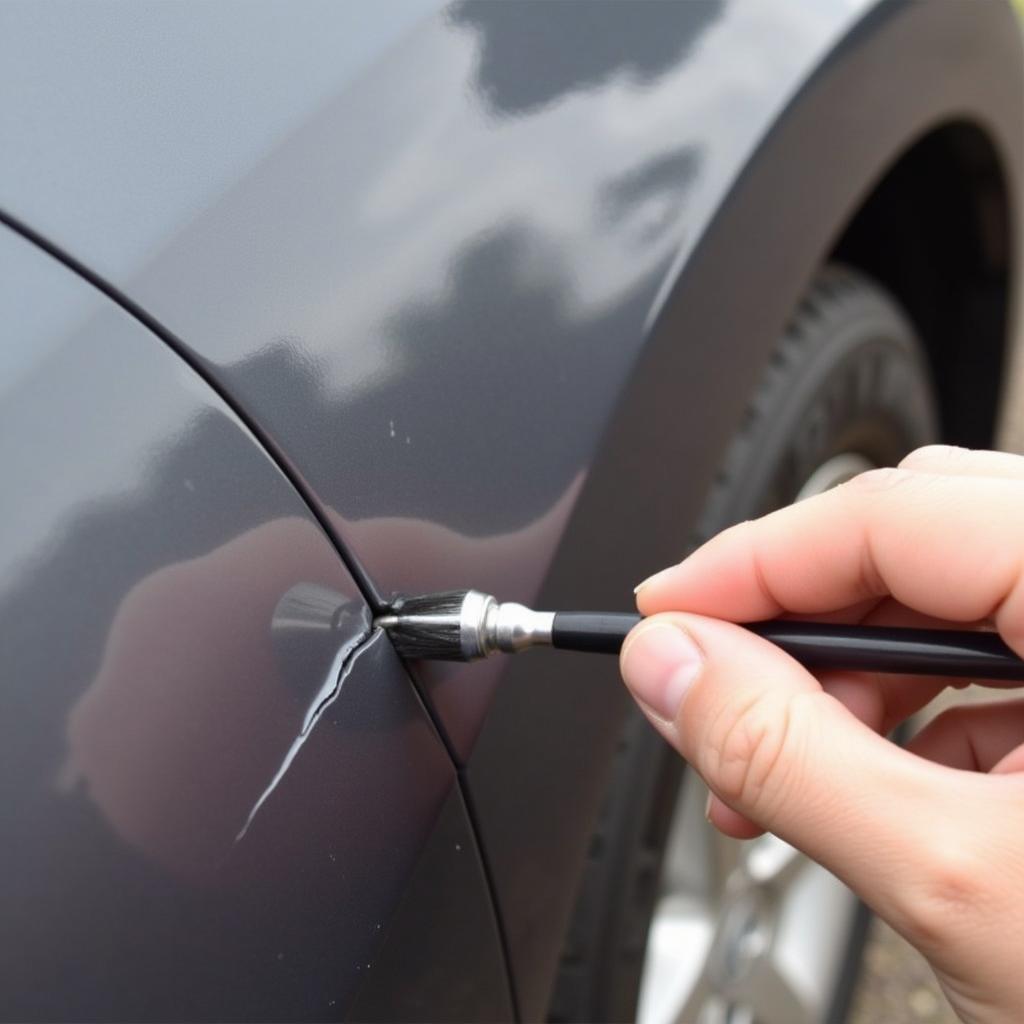Cracked car paint isn’t just an eyesore; it can lead to rust and further damage. Learning How To Fix A Crack In Car Paint can save you money and keep your car looking its best. This comprehensive guide will walk you through the process, from identifying the cause to achieving a professional-looking repair. Let’s dive in and restore that flawless finish! how to fix paint cracking on car
Understanding the Causes of Cracked Car Paint
Before you begin to fix cracked car paint, understanding the root cause is crucial for long-term success. Common culprits include:
- Impact Damage: Rocks, debris, and even minor collisions can cause stress fractures in the paint.
- Poor Paint Application: Improper surface preparation, thin coats, or low-quality paint can lead to premature cracking.
- Environmental Factors: Extreme temperatures, UV exposure, and harsh weather conditions can weaken the paint’s integrity.
- Age: Over time, paint naturally loses its elasticity and becomes more susceptible to cracking.
Assessing the Damage and Gathering Your Supplies
Once you’ve identified the likely cause, carefully assess the extent of the cracking. Is it superficial, or does it penetrate deep into the paint layers? This will determine the appropriate repair method. For minor cracks, you’ll need:
- Car Wash Soap and Water: Thoroughly cleaning the area is essential for proper adhesion.
- Fine-Grit Sandpaper (2000-3000 grit): Used for smoothing the cracked area.
- Rubbing Compound: Helps to remove minor scratches and blend the repair.
- Touch-Up Paint: Choose a paint that precisely matches your car’s color.
- Clear Coat: Protects the touch-up paint and restores shine.
- Applicator Pads or Brushes: For applying the paint and clear coat.
- Masking Tape: Protects surrounding areas during the repair process.
Step-by-Step Guide to Fixing Cracked Car Paint
Fixing minor cracks is a DIY-friendly project. Here’s a step-by-step guide:
- Clean the Area: Wash the affected area thoroughly with car wash soap and water. Rinse and dry completely.
- Sand the Crack: Using fine-grit sandpaper, gently sand the cracked area to smooth out the edges and create a level surface for the touch-up paint.
- Apply Touch-Up Paint: Carefully apply thin coats of touch-up paint to the cracked area, allowing each coat to dry before applying the next. fix cracked car paint
- Apply Clear Coat: Once the touch-up paint is dry, apply a thin layer of clear coat to protect the repair and restore shine.
- Buff and Polish: After the clear coat has dried, use rubbing compound and a polishing pad to blend the repair seamlessly with the surrounding paint.
 Applying touch-up paint to a car’s cracked paint
Applying touch-up paint to a car’s cracked paint
When to Call a Professional
For severe cracking or damage that penetrates through multiple layers of paint, it’s best to consult a professional auto body shop. They have the expertise and equipment to handle more complex repairs, including:
- Deep Cracks and Paint Chipping: These may require repainting the entire panel for a uniform finish.
- Rust Formation: If the crack has exposed the metal underneath, rust removal and treatment will be necessary before repainting. how to fix cracks in car paint
- Structural Damage: If the crack is accompanied by dents or other structural damage, professional repair is essential.
“Addressing cracked paint promptly is essential to prevent further damage and maintain your car’s value,” advises John Miller, a seasoned auto body technician with over 20 years of experience. “A small crack can quickly escalate into a major issue if left untreated.”
Preventing Future Cracks in Your Car Paint
Prevention is always the best medicine. Here are some tips to keep your car’s paint looking its best:
- Regular Washing and Waxing: This protects the paint from environmental contaminants and UV damage.
- Park in the Shade: Minimize exposure to direct sunlight and extreme temperatures.
- Address Minor Damage Promptly: Repairing small chips and scratches before they develop into cracks can save you time and money. fix a dent in car price
Conclusion
Knowing how to fix a crack in car paint empowers you to maintain your car’s appearance and prevent further damage. By following the steps outlined in this guide, you can address minor cracks effectively and keep your car looking its best. Remember, prompt action is key to preventing a small problem from becoming a major headache. For more complex repairs or if you’re unsure about tackling the job yourself, don’t hesitate to contact a professional auto body shop. Connect with AutoTipPro at +1 (641) 206-8880 or visit our office at 500 N St Mary’s St, San Antonio, TX 78205, United States for expert assistance.
FAQ
- Can I use nail polish to fix a crack in my car paint? While tempting, nail polish is not recommended as it doesn’t adhere well to car paint and can cause further damage.
- How long does touch-up paint take to dry? Drying times vary depending on the product and environmental conditions, but generally allow at least 24 hours for complete drying.
- What is the best way to match my car’s paint color? Check your owner’s manual or the sticker inside the driver’s side doorjamb for the paint code. Automotive paint suppliers can use this code to create a precise match.
- How often should I wax my car? Waxing every 3-4 months provides optimal protection for your car’s paint.
- Can cracked car paint be repaired in the winter? While possible, ideal temperatures for paint repair are between 60 and 80 degrees Fahrenheit. Cold temperatures can affect drying times and adhesion.
- Is it necessary to use clear coat after applying touch-up paint? Yes, clear coat protects the touch-up paint, adds shine, and helps to blend the repair with the surrounding paint. how to fix a saddy car head liner
- What if the crack is deeper than the surface of the paint? Deeper cracks require more extensive repair, and it’s best to consult a professional for optimal results.




Leave a Reply